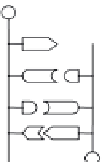Biology Reference
In-Depth Information
should then lead to the design of improved chemotherapeutic agents
and regimens.
Nowadays, the amount of microarray-based literature is vast, and the
methods for analyzing gene chip data are becoming increasingly more
technical. As microarrays of increasing gene density are made, we need
better methods for processing and organizing huge amounts of data
for easy access and analyses. Microarray research has been supported by
innovative methods from the new field of bioinformatics, the discipline
that studies the application of computer technology to the management
of biological information. Emerging at the interface of biology,
mathematics, and computer science, bioinformatics allows data
organization, manipulation, and analysis at a scale that would otherwise
be impossible.
We begin this chapter with a brief review of the technologies used to
manufacture microarrays and some of the ways in which they are being
utilized. We then describe some methods for data processing and
analyses designed to quantify the results from microarray experiments.
We present some of the mathematical background pertinent to designing
clustering methods and then turn to some analytical tools developed
to study circadian gene expression.
I. FABRICATING AND USING MICROARRAYS
A. Producing Labeled cDNA
DNA strand
Recall from Chapter 11 that the ultimate result of gene expression is the
production of proteins, which are the translation products of messenger
RNAs (mRNAs). Gene expression occurs via RNA synthesis, called
transcription, the process in which one of the two strands of the DNA is
used to direct the production of an RNA molecule, as diagrammed in
Figure 12-1. The nitrogenous bases of RNA (A, C, G, and U) hydrogen-
bond to the nitrogenous bases of the DNA, with A binding to U and C
binding to G.
RNA strand
Transcription
FIGURE 12-1.
Graphic representation of transcription (RNA
synthesis). The DNA strand at left is being copied
during the production of RNA. The RNA is here
distinguished from the DNA by the small boxes
attached to the diagram, which represent the
additional hydroxyl groups that differentiate the
ribose sugar of RNA from the deoxyribose sugar
of DNA.
The product of the transcription of protein coding genes is mRNA, so we
can isolate mRNA from the cells of interest and use the amount of
mRNA as a proxy for the amount of protein produced by the cell.
Because mRNA is an extremely fragile, short-lived molecule, vulnerable
to seemingly ubiquitous ribonuclease enzymes, it would be difficult to
use mRNA in microarray-based experiments. However, the mRNA can
be converted into a more durable form called complementary DNA
(cDNA). The cDNA is made from the mRNA and is complementary to it.
This means that the cDNA can be used in place of the mRNA to
investigate gene expression.


















